Across the globe, AI-driven art is redefining what it means to create and experience art. Machine learning, neural networks, and sophisticated algorithms allow artists to generate innovative works that challenge traditional boundaries. Contemporary galleries are quickly adapting, curating exhibitions featuring art born from artificial intelligence. These changes are reshaping the gallery landscape in profound ways.
The Rise of AI in Artistic Creation
Artificial intelligence has woven itself into the fabric of the creative process. AI programs learn from enormous datasets, analyzing styles, colors, and compositions from historic masterpieces. Artists use these algorithms to generate unique visuals, sometimes collaborating directly with the machine as a creative partner. The result often blurs the line between human intention and machine autonomy. Creating with AI shifts artistic expression from the solitary vision of the artist to a complex interplay between coder, data, and algorithm.
Reimagining Gallery Spaces
Galleries worldwide are evolving to keep pace with this artistic revolution. Traditional white-wall spaces are now hosting immersive AI installations and interactive digital artworks. Curators craft exhibitions that invite visitors to engage with art on a multisensory level. Some installations react in real time to viewers’ movements, facial expressions, or even spoken words. These dynamic exhibitions transform passive viewership into active participation, making each gallery visit unique.
Blurring the Line Between Artist and Audience
AI-driven art often involves more than viewing; it demands interaction. Visitors might influence an artwork’s evolving patterns or colors through gestures or input from their smartphones. This technological integration redefines the role of the audience, turning them into co-creators. By incorporating AI, galleries break down barriers between artist, artwork, and observer, fostering collective creativity.
Showcasing Diversity in Media and Methods
Contemporary galleries now showcase an ever-wider variety of art forms and creative mediums. AI-generated paintings, algorithmically designed sculptures, and data-driven installations often sit beside traditional works. Using generative adversarial networks, artists can create hyperrealistic images or abstract visual poetry without ever touching a paintbrush. This new art democratizes access to artistic tools, allowing creators from non-traditional backgrounds to participate and innovate.
Collaboration and Interdisciplinary Approaches
AI-driven art often flourishes at the intersection of art, science, and technology. Many contemporary galleries host exhibitions developed through collaborations between artists, programmers, and researchers. Conferences and workshops frequently accompany these shows, providing deeper insights into the technology behind the pieces. This interdisciplinary environment fosters ongoing dialogue and shifts how the art world values collaboration.
Redefining Curatorship and Interpretation
Curators are discovering that AI-driven art demands new approaches to exhibition planning and interpretation. The process of curating interactive, changing artworks is fundamentally different from hanging static paintings on a wall. Curators now frequently consult with software engineers and AI researchers during each phase of exhibition design. Together, they ensure installations function smoothly and provide meaningful visitor experiences.
New Narratives and Visitor Engagement
AI-generated art raises questions about authorship, creativity, and the value of originality. Guided tours and educational programs in galleries address these questions, engaging audiences in thoughtful discussions. As a result, visitors leave with not only an appreciation of the artwork but also a deeper understanding of the technological context in which it was created. The interpretive role of galleries grows in importance as art becomes more complex.
Expanding the Global Reach of Art
One of the most transformative aspects of AI-driven art is its power to connect artists and audiences internationally. Digital tools and online platforms allow for the instantaneous sharing of artworks across continents. Galleries host virtual exhibitions, accessible from almost anywhere in the world. This expanded reach levels the playing field for emerging artists, providing global exposure without logistical barriers.
Breaking Down Cultural Barriers
AI-generated art’s universal language enables cross-cultural dialogue. Visitors from different backgrounds can experience, interpret, and share AI-driven artworks freely. As galleries embrace these technologies, they also contribute to global conversations about technology, ethics, and creativity. This cross-pollination of ideas enriches the art world, introducing fresh perspectives and innovations.
Addressing Ethical Considerations
With rapid adoption of AI in art creation and curation, ethical concerns have surfaced. Issues like data bias, copyright, and transparency in algorithms challenge artists and curators alike. Many galleries foster open dialogue, inviting legal experts and technologists to discuss these complex questions publicly. The art world must develop new ethical frameworks as AI-generated art continues to evolve.
Ensuring Equitable Representation
Data sets used to train AI often reflect existing biases. Contemporary galleries are taking proactive steps to ensure diversity and representation in their exhibitions. Selecting inclusive training data and diverse collaborators helps mitigate bias and promote fairness within AI-generated artworks. These efforts indicate a commitment to equitable practices as technology becomes more central to art production.
Anticipating the Future of Art in Galleries
As AI-driven art matures, the possibilities for galleries seem limitless. Advances in machine learning will unlock new creative methods and interactive experiences. Future exhibitions may integrate augmented reality, haptic feedback, or even brain-computer interfaces. These innovations promise to deepen audience engagement and elevate artistic impact. Such rapid evolution will demand continual adaptation from curators, artists, and institutions alike.
Conclusion: Embracing a New Era
AI-driven art is much more than a passing trend; it is fundamentally changing how we create, curate, and experience art. Contemporary galleries around the world are embracing these changes, inviting visitors to explore the intersection of technology and imagination. By fostering inclusivity, promoting dialogue, and remaining agile, the global art community is shaping a new era of creative expression. The transformation of the gallery landscape is underway, and its future promises endless innovation and excitement.

